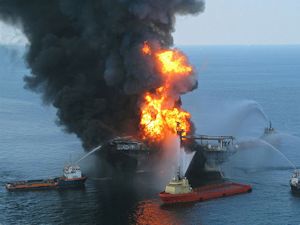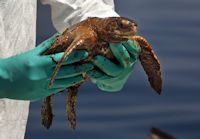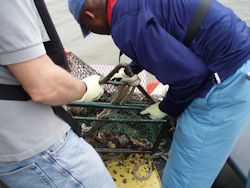SEJournal Online is the digital news magazine of the Society of Environmental Journalists. Learn more about SEJournal Online, including submission, subscription and advertising information.

April 20, 2015, marks the fifth anniversary of the BP Deepwater Horizon oil spill in the Gulf of Mexico, one of the largest environmental disasters in U.S. history. Its impacts are still reverberating. And the story is far from over. If you are covering the legacy of the spill, this month the Society of Environmental Journalists is offering two special TipSheets that will help you get the facts and background. Both were done by Amy Wold, who has been covering the spill for the Baton Rouge/New Orleans Advocate. The first is "Follow the Money" (below) and the second is "Follow the Science."
BP Deepwater Horizon Anniversary: Follow the Money
By Amy Wold for the Society of Environmental Journalists
 |
|
Platform supply vessels battle the blazing remnants of the off shore oil rig Deepwater Horizon. A Coast Guard MH-65C dolphin rescue helicopter and crew document the fire aboard the mobile offshore drilling unit Deepwater Horizon, while searching for survivors. Multiple Coast Guard helicopters, planes and cutters responded to rescue the Deepwater Horizon's 126 person crew. Credit: U.S. Coast Guard |
When the Deepwater Horizon drill rig exploded in the Gulf of Mexico on April 20, 2010, killing 11 men and leading to one of the worst oil spills in United States history, immediate concern turned to how at least the ecological damage could be repaired.
There was considerable effort and pressure put on government to steer the fines and other restoration payments toward the Gulf of Mexico states that received damage during the spill.
Following the money on this story can be a little convoluted. We hope this Special Edition TipSheet will make it a little easier for reporters planning anniversary coverage to break down the who, what, how much, and where of settlement money in this story.
This white paper from the Environmental Law Institute and the Tulane Institute on Water Resources Law and Policy gives a good overview of the way that money is being distributed. Page 23 has a handy chart listing the funding sources, purpose, money committed to the program, and when that money would become available.
This report by the Congressional Research Service from May 2014 also gives a rundown of money paid out by BP for cleanup and response efforts and who that money went to.
RESTORE Act's Gulf Coast Restoration Trust Fund
 |
|
One of 10 heavily oiled Kemp's Ridley turtles recovered not far from the site of the Deep Horizon accident site on June 14, 2010. Credit: Carolyn Cole/ LA Times; courtesy NOAA. |
The RESTORE Act of 2012 allocates 80 percent of Clean Water Act penalties to Gulf of Mexico states, but it does have a lot of moving parts and divisions specifying where the money goes.
Here are three versions of the graphic that give the same information presented in different ways: a comparison, a flow chart, and an overview.
In the most simple terms, the RESTORE Act funding is divided as follows:
- 35 percent in equal parts to Alabama, Florida, Louisiana, Mississippi, and Texas for ecological and economic restoration
- 30 percent to the Gulf Coast Ecosystem Restoration Council to carry out a comprehensive recovery plan
- 30 percent to the five Gulf of Mexico states based on a formula that includes the number of miles of oiled shoreline per total miles of shoreline, average distance of the Deepwater Horizon rig to each state's oiled shoreline and population of coastal counties based on 2010 census
- 2.5 percent to do ecosystem monitoring, restoration science and technology
- 2.5 percent to help pay for Centers of Excellence in each state
Those centers have been selected and they are:
- Florida – Florida Institute of Oceanography
- Alabama – Dauphin Island Sea Lab
- Mississippi – The University of Mississippi’s Center for Gulf Studies
- Louisiana – The Water Institute of the Gulf
- Texas – Two consortiums with multiple universities
The National Fish and Wildlife Foundation's Gulf Environmental Benefit Fund, totalling $2.5 billion over five years, was set up by the courts in response to two plea agreements on criminal cases involving BP and Transocean. Explanation here.
The Transocean settlement is here.
In Louisiana, the money has gone to barrier island and river diversion projects, meant to take freshwater and sediment from the Mississippi River into the coastal marshes for restoration purposes.
In Alabama, Florida, Mississippi, and Texas the money was meant to help solve ecosystem problems. The map on this page links to each state's approved projects.
Natural Resource Damage Assessment (NRDA)
 |
|
An oiled marsh seen during an overflight on May 20, 2010. Credit: NOAA. |
Under the Oil Pollution Act of 1990, the Natural Resource Damage Assessment process is meant to get federal and state agencies, along with Indian tribes and the responsible party, to define injuries to natural resources. After damages are quantified, there is then a negotiation, conducted in private, to determine and agree upon a dollar amount that is meant to compensate for those damages.
The National Oceanic and Atmospheric Administration is the lead agency for the process. Some general information is here. More details on what is being looked at are here.
Since this process was expected to take years, BP agreed to a type of down payment on the eventual settlement through the Oil Pollution Act of 1990 Natural Resource Damage Assessment.
This early restoration money was meant to start work on repairing damages that would be taken off the eventual Natural Resource Damage Assessment total. What is known as NRDA (ner-da) is a lengthy legal process, to scientifically assess the damage an oil spill did and then agree on a money amount to repair that damage. However, in 2011 BP set aside $1 billion as a down payment on this eventual amount. The money was distributed in phases which are outlined here with specifics on the projects approved.
The Oil Spill Liability Trust Fund goes primarily toward covering costs of responding to an oil spill, although some of the money can be used if there needs to be compensation to victims and the responsible party can't pay.
The North American Wetlands Conservation Fund received a court award of $100 million from a BP guilty plea agreement with the Department of Justice related to violations of the Migratory Bird Treaty Act. The money will be distributed through a grant program.
The National Academy of Sciences received $500 million from BP and Transocean as part of a criminal plea agreement, with the money to go toward a 30-year Gulf Research Program. The three goals are oil system safety, human health, and environmental resources.
Court Cases
 |
|
Dr. Dennis Apeti, Mussel Watch scientist, brings up a trawl full of oysters for testing. Credit: NOAA. |
Although there have been many court cases involving the 2010 Deepwater Horizon oil spill, the one being watched most closely now is the decision on how much BP will have to pay in Clean Water Act fines (which pays into the RESTORE Act funding mentioned above).
There is a good rundown here from the Environmental Law Institute. ELI also offers a breakdown of how much money could be involved.
Tulane Institute on Water Resources Law and Policy came out with a fact sheet to help explain the Sept. 4, 2014, announcement from district court that the spill occurred because of gross negligence and willful misconduct on the part of BP.
That was from an earlier phase of the trial. The latest phase to assess what penalty BP will pay under the Clean Water Act ended Feb. 2, 2015. A decision hasn't been issued yet.
This website from the U.S. District Court, Eastern District of Louisiana, gives updates on the progress as well as links to documents and orders. U.S. District Judge Carl J. Barbier is overseeing the Clean Water Act case.
From the BP-run The State of the Gulf website are a number of links to the company's response and position.
Here is a summary of EPA's cases involving the Deepwater Horizon.












 Advertisement
Advertisement 



